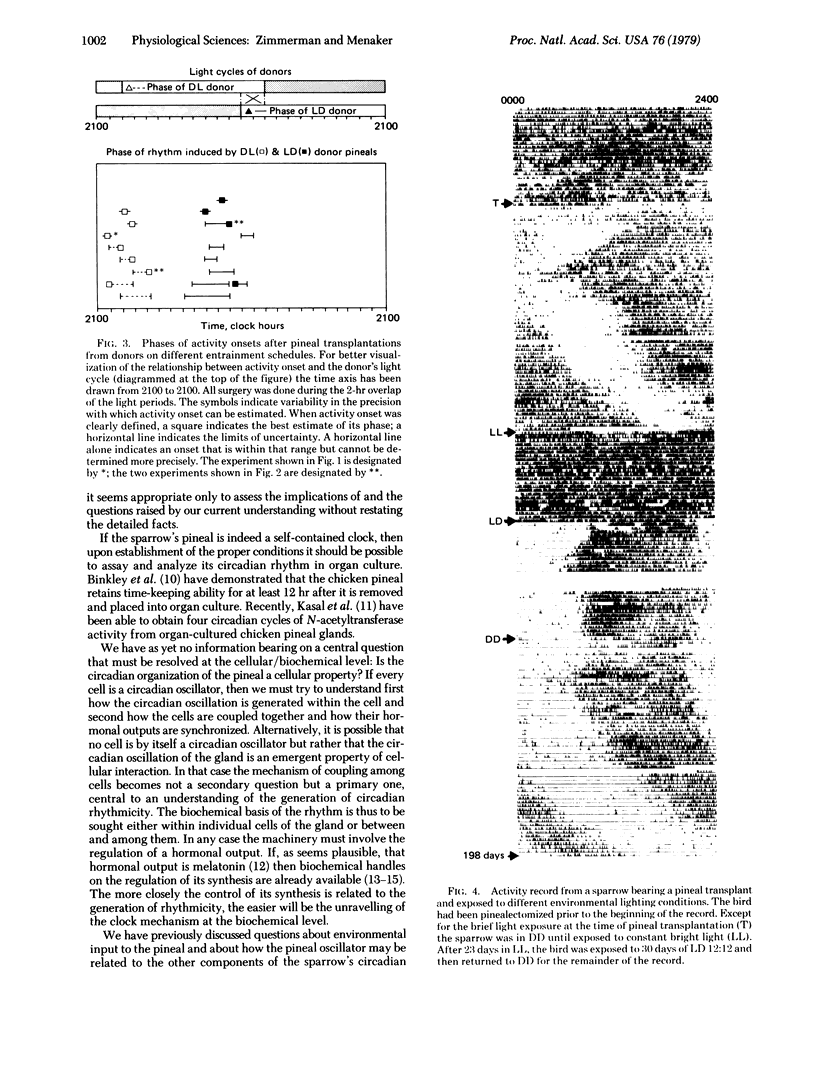Abstract
Transplantation of pineal tissue into the anterior chamber of the eye rapidly reestablishes rhythmicity in arhythmic pinealectomized sparrows and also transfers the phase of the donor bird's rhythm to the host. Thus, the transplanted pineal does not merely permit rhythmicity to be expressed but rather transfers an oscillation that controls the remainder of the circadian system and restores the capacity for self-sustained rhythmicity. Long-term recordings, during which sparrosw were exposed to various lighting conditions, demonstrate a remarkable similarity between the circadian system in normal birds and that in birds bearing pineal transplants.
Full text
PDF




Selected References
These references are in PubMed. This may not be the complete list of references from this article.
- Adler K. Extraocular photoreception in amphibians. Photophysiology. 1976 Apr;23(4):275–298. [PubMed] [Google Scholar]
- Binkley S., Kluth E., Menaker M. Pineal function in sparrows: circadian rhythms and body temperature. Science. 1971 Oct 15;174(4006):311–314. doi: 10.1126/science.174.4006.311. [DOI] [PubMed] [Google Scholar]
- Binkley S., Macbride S. E., Klein D. C., Ralph C. L. Regulation of pineal rhythms in chickens: refractory period and nonvisual light perception. Endocrinology. 1975 Apr;96(4):848–853. doi: 10.1210/endo-96-4-848. [DOI] [PubMed] [Google Scholar]
- Binkley S. Pineal gland biorhythms: N-acetyltransferase in chickens and rats. Fed Proc. 1976 Oct;35(12):2347–2352. [PubMed] [Google Scholar]
- Binkley S., Riebman J. B., Reilly K. B. Timekeeping by the pineal gland. Science. 1977 Sep 16;197(4309):1181–1183. doi: 10.1126/science.897660. [DOI] [PubMed] [Google Scholar]
- Gaston S., Menaker M. Pineal function: the biological clock in the sparrow? Science. 1968 Jun 7;160(3832):1125–1127. doi: 10.1126/science.160.3832.1125. [DOI] [PubMed] [Google Scholar]
- Hartwig H. G. Electron microscopic evidence for a retinohypothalamic projection to the suprachiasmatic nucleus of Passer domesticus. Cell Tissue Res. 1974;153(1):89–99. doi: 10.1007/BF00225448. [DOI] [PubMed] [Google Scholar]
- Menaker M., Takahashi J. S., Eskin A. The physiology of circadian pacemakers. Annu Rev Physiol. 1978;40:501–526. doi: 10.1146/annurev.ph.40.030178.002441. [DOI] [PubMed] [Google Scholar]
- Ralph C. L., Binkley S., MacBride S. E., Klein D. C. Regulation of pineal rhythms in chickens: effects of blinding, constant light, constant dark, and superior cervical ganglionectomy. Endocrinology. 1975 Dec;97(6):1373–1378. doi: 10.1210/endo-97-6-1373. [DOI] [PubMed] [Google Scholar]
- Reiter R. J., Sorrentino S., Jr Reproductive effects of the mammalian pineal. Am Zool. 1970 May;10(2):247–258. doi: 10.1093/icb/10.2.247. [DOI] [PubMed] [Google Scholar]
- Turek F. W., Desjardins C., Menaker M. Differential effects of melatonin on the testes of photoperiodic and nonphotoperiodic rodents. Biol Reprod. 1976 Aug;15(1):94–97. doi: 10.1095/biolreprod15.1.94. [DOI] [PubMed] [Google Scholar]
- Turek F. W., McMillan J. P., Menaker M. Melatonin: effects on the circadian locomotor rhythm of sparrows. Science. 1976 Dec 24;194(4272):1441–1443. doi: 10.1126/science.1006311. [DOI] [PubMed] [Google Scholar]
- Underwood H. Circadian organization in lizards: the role of the pineal organ. Science. 1977 Feb 11;195(4278):587–589. doi: 10.1126/science.835015. [DOI] [PubMed] [Google Scholar]
- Zimmerman N. H., Menaker M. Neural connections of sparrow pineal: role in circadian control of activity. Science. 1975 Oct 31;190(4213):477–479. doi: 10.1126/science.1166318. [DOI] [PubMed] [Google Scholar]


